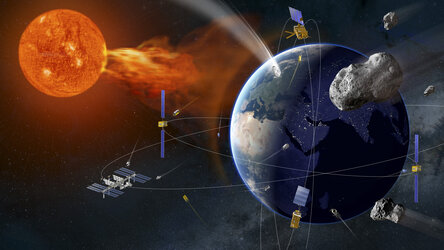1. Introduction
In 1957 a major event marked the beginning of a new era in Earth Observation: the first artificial satellite (Sputnik) was launched by the Soviet Union.
In astronomy, a satellite will be understood as a celestial body orbiting around a planet or another celestial body (a moon). One satellite that everyone knows about is the Moon.
Generally, it is said that the Moon is a “natural satellite” because it is not man-made. By comparison, “artificial satellites” are man-made objects orbiting around celestial bodies.

A satellite cannot “fly” per se and is unable to leave the Earth’s surface on its own. It needs to be launched by a rocket.
Satellites do not fly, they move following an orbit. The orbit is the path followed by any celestial body moving around a bigger celestial body. Usually the orbit is of a quasi-circular shape.
Examples of orbits are those of the Earth around the Sun and of the Moon around the Earth.
Today, satellites are very common platforms used in remote sensing; they carry a great diversity of sensors, often specialised to observe specifically the weather, landscapes or natural disasters, vegetation; some are even capable of “seeing” through clouds or acquiring imagery at night. Two great advantages of satellites with respects to planes are that large areas can be covered with their images and the same area can be observed systematically at every satellite pass.
For example, it would be a huge undertaking for an aircraft to flight over an entire ocean to spot oil slicks potentially left by a boat. With a satellite, the task is much easier. The sensor on board a satellite takes regular images of the ocean and an expert just needs to look at the satellite images to determine if the ocean is clean.















 Germany
Germany
 Austria
Austria
 Belgium
Belgium
 Denmark
Denmark
 Spain
Spain
 Estonia
Estonia
 Finland
Finland
 France
France
 Greece
Greece
 Hungary
Hungary
 Ireland
Ireland
 Italy
Italy
 Luxembourg
Luxembourg
 Norway
Norway
 The Netherlands
The Netherlands
 Poland
Poland
 Portugal
Portugal
 Czechia
Czechia
 Romania
Romania
 United Kingdom
United Kingdom
 Slovenia
Slovenia
 Sweden
Sweden
 Switzerland
Switzerland


































